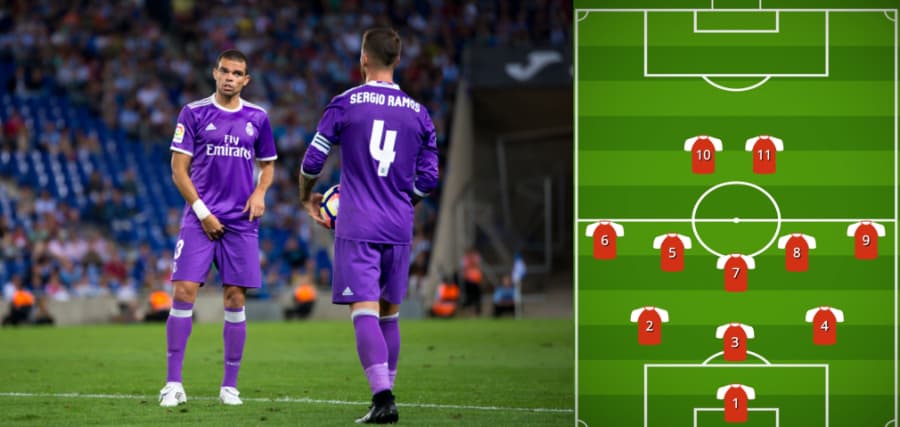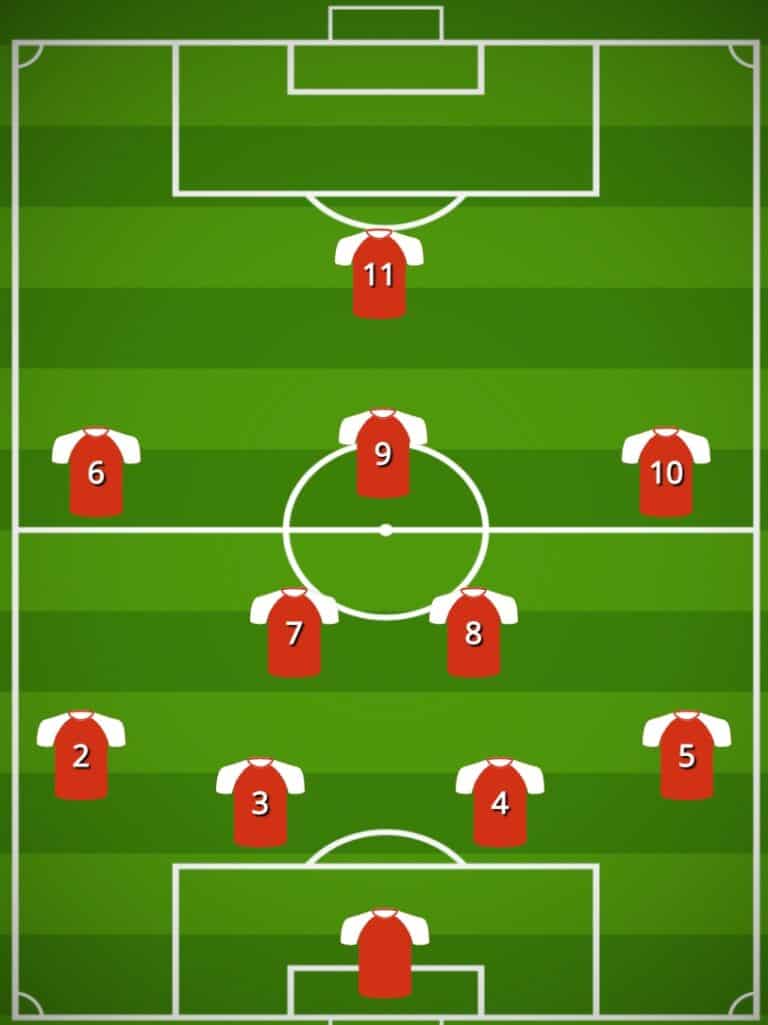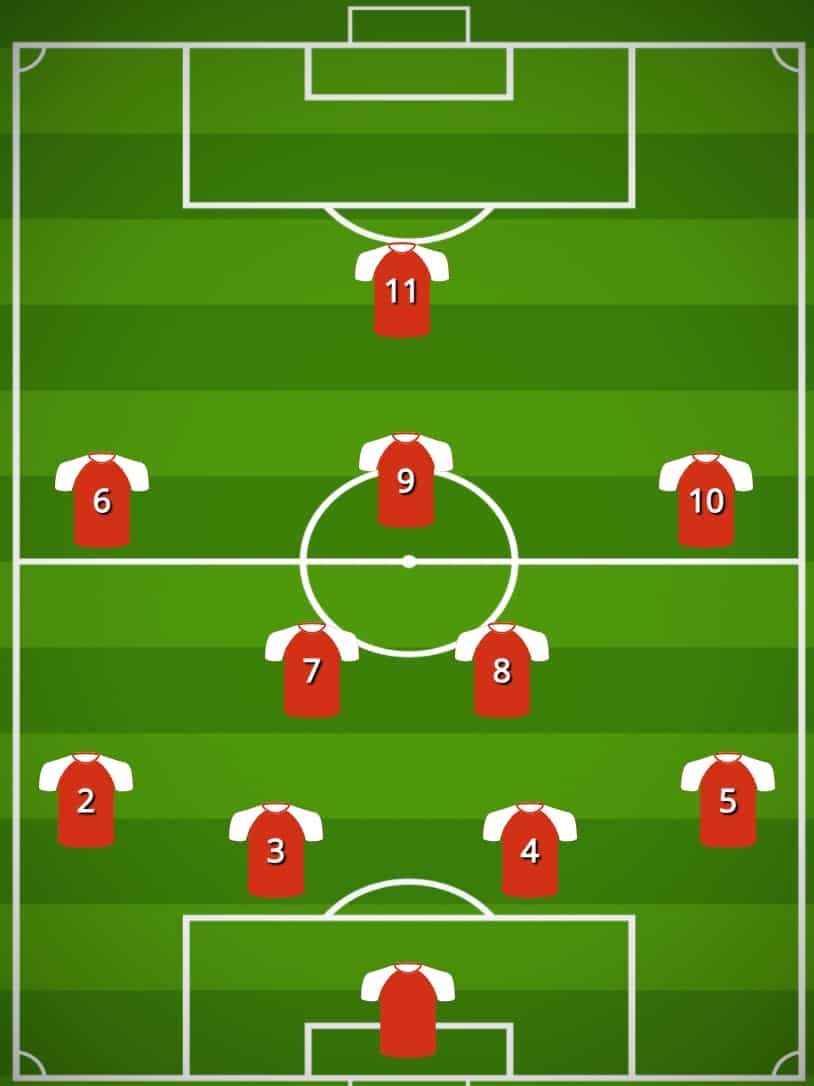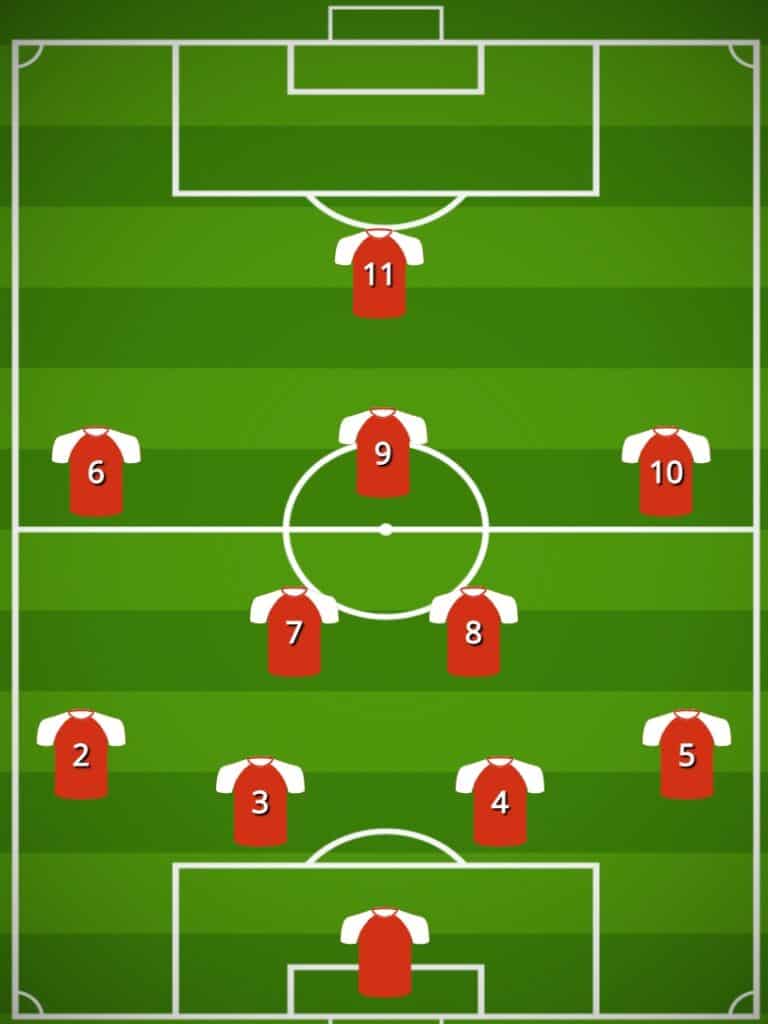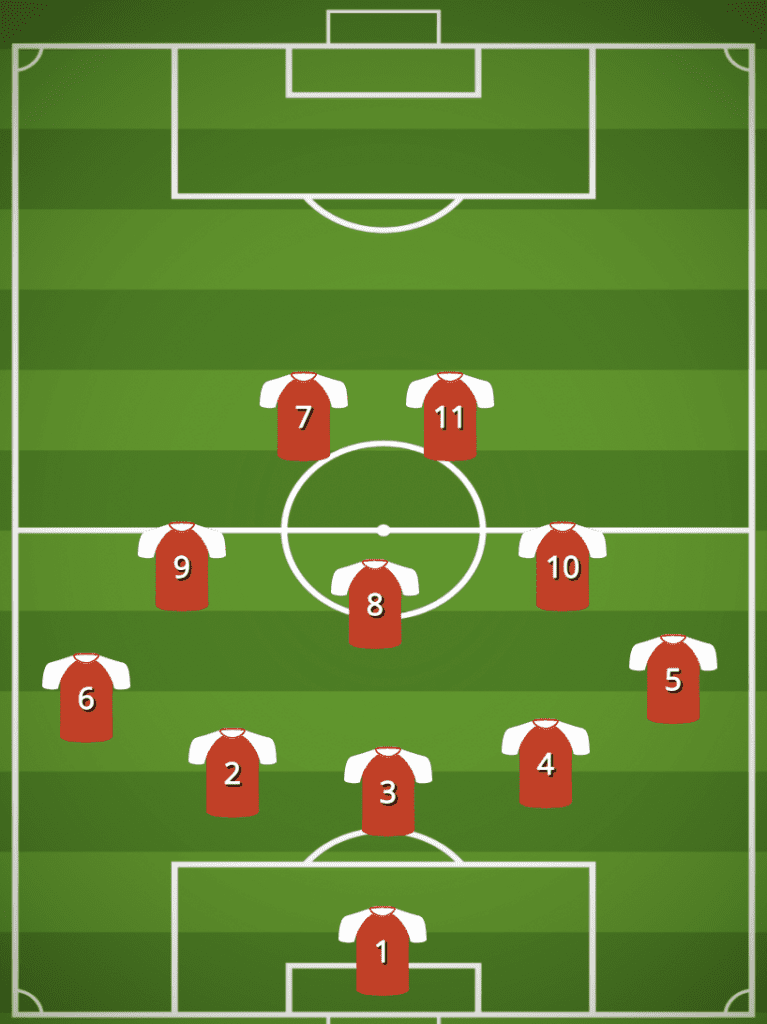The 3-5-2 formation, which gained fame with the 1986 World Cup-winning Argentina side, is known for its flexibility and ability to cause havoc for opposing teams. In this article, we’ll explore four formations that can be used to counter the 3-5-2 and provide a tactical advantage. By understanding the main threats and strategizing accordingly, teams can turn the tables and neutralize the effectiveness of the 3-5-2 formation.
Bạn đang xem: The Most Effective Formations Against the 3-5-2
The Versatile 4-2-3-1 Formation (Nullify by Attacking)
The 4-2-3-1 formation has become a popular choice for many teams due to its sleek, attacking style. It offers the ability to overload opponents both through the middle and on the wings. Against the 3-5-2 formation, the two attacking wingers of the 4-2-3-1 can force the wingbacks of the 3-5-2 to defend more, limiting their attacking threat. This formation allows teams to maintain control of the game while putting pressure on the opposing team’s defense. Although it requires cohesion in the defensive aspect, the 4-2-3-1 formation offers a great attacking option against the 3-5-2.
Pros:
- It’s a favored attacking formation among elite teams.
- The wingers can force the 3-5-2 into a defensive shape.
- Exciting attacking soccer can be expected from both teams.
Cons:
- If the wingers are unable to maintain their attacks, the wingbacks can exploit the spaces left behind.
- Team cohesion may be compromised as players adjust to unfamiliar positions.
The Balanced 5-3-2 Formation (Counter by Copying)
The 3-5-2 and 5-3-2 formations share similarities, particularly in their use of wingbacks as primary attacking threats. By adopting a similar shape to the 3-5-2, teams can neutralize the dangerous wingbacks of the opposing team. In the 5-3-2 formation, the wingbacks play a more defensive role, preventing the 3-5-2’s wingbacks from being as effective. Although this formation sacrifices some attacking capabilities, it offers a solid counter to the 3-5-2 by minimizing its key strengths. A weaker team can opt for this formation and use long balls to launch counterattacks, catching the opponents off guard and creating more attacking opportunities.
Pros:
- The formation can quickly switch between various setups, including a 3-5-2, to match the opponent’s tactics.
- It provides a five-man defense and the option to reinforce the defensive midfield.
- The formation is effective in counterattacks against the vulnerable 3-5-2.
Cons:
- It can be a complex tactic to master, particularly if not regularly used.
- The formation relies heavily on the wingbacks’ performance.
- Poor tracking back or inefficient transitions into attack can cause the formation to fail.
The Ultra-Defensive 5-4-1 Formation
Sometimes, teams need to rely on sheer defensive strength to see out a game. The 5-4-1 formation provides just that, with the aim of frustrating the attacking threat of the 3-5-2. This formation demands discipline, teamwork, and concentration from all players, as any lapse in focus can lead to devastating consequences. By employing a solid five-person defense and four defensive-minded midfielders, teams can thwart the 3-5-2’s attacking overload. While not the most attractive formation, the 5-4-1 can effectively neutralize the 3-5-2, earning valuable points against a stronger opponent.
Pros:
- The formation can completely shut down the opponent’s attacking efforts.
- Weaker players are compensated for by the strong defensive unit.
- Set pieces offer opportunities for surprise attacks.
Cons:
- The formation may be perceived as unattractive by fans, resulting in a stagnant game.
- Offensive capabilities are limited, as pushing players forward risks counterattacks.
The Dynamic 4-3-3 Formation (DMC and Attacking Wingers)
The most effective formation against the 3-5-2 is the 4-3-3. With its flat-back-four, defensive midfielder, two central midfielders, two wingers, and a striker, the 4-3-3 combats the threats posed by the 3-5-2 formation. The defensive midfielder plays a crucial role in slowing down the opposing wingbacks and providing cover for the defense. The wingers force the opponent’s wingbacks into defensive duties, drastically reducing their attacking threat. This formation maintains defensive solidity while offering multiple attacking options. The versatility of the 4-3-3 makes it not only the best formation against the 3-5-2 but also one of the best soccer formations overall.
Pros:
- The 4-3-3 provides defensive stability with four defenders at all times.
- The defensive midfielder ensures additional security and contributes to the attack.
- Wingers force the opponent’s formation to become compact and less threatening.
Cons:
- The two formations can sometimes cancel each other out, but the added security is worth it.
- Mastering the complex tactics of the 4-3-3 requires cohesion and may be prone to mistakes.
- The lone striker may face challenges when marked by three center-backs.
FAQs
🏟 Why is the 3-5-2 formation considered so flexible?
The 3-5-2 formation is revered for its flexibility because it can quickly morph into several other setups, depending on the game’s flow. This adaptability allows teams to defend en masse or attack with numbers as needed.
🏃♂️ How did Diego Maradona benefit from the 3-5-2 formation?
Diego Maradona thrived in the 3-5-2 formation, especially during the 1986 World Cup. Playing as an attacking midfielder just behind the main striker, Maradona created an overload in midfield that forced defenders to mark him. This tactic created space for other players, such as the wingbacks, to exploit.
⚽ How important are wingbacks in the 3-5-2 setup?
Wingbacks play a pivotal role in the 3-5-2 formation. Offensively, they provide width, deliver crosses, and join the attack. Defensively, they drop back to form a five-man defense line. They act as a bridge, balancing the team between defense and attack.
📊 Is there a statistical advantage to using the 3-5-2 formation?
Xem thêm : 7 Best Soccer Cleats For Women
Historically, teams using the 3-5-2 formation have enjoyed a decent share of possession due to its natural ability to control the midfield. Additionally, successful teams like the 1986 Argentina side have showcased the effectiveness of this formation. However, its success is greatly influenced by the players’ quality and understanding of their roles.
🧠 Why is the defensive midfielder so crucial in the 4-3-3 formation?
The defensive midfielder (DM) in the 4-3-3 setup acts as a shield for the defense and a bridge to the attacking midfielders. This player breaks up opponent plays, intercepts passes, and initiates counterattacks. Additionally, the DM’s versatility allows them to act as a deep-lying playmaker, dictating the game’s tempo with precise passes.
💨 How effective is a counter-attack strategy against a 3-5-2?
While the 3-5-2 formation is solid in possession, it can be vulnerable to quick counter-attacks, especially when the wingbacks are caught upfield. Teams with fast wingers or forwards can exploit the space behind the advancing wingbacks, putting pressure on the three central defenders. Many opponents choose to adopt a counter-attacking strategy to exploit this vulnerability.
📉 What are the potential pitfalls of the 5-4-1 formation?
Although the 5-4-1 formation provides a solid defensive setup, it comes with drawbacks. It can be too defensive, limiting offensive capabilities. Additionally, maintaining defensive shape for the entire match can exhaust players mentally and physically. If the midfield fails to link up with the sole striker, the forward may become isolated and ineffective.
🔍 Which teams have effectively used the 3-5-2 formation?
The 1986 Argentina national team, led by Carlos Bilardo, is one of the most famous examples of a team using the 3-5-2 formation effectively. In club football, Antonio Conte’s Juventus and Chelsea sides were successful with this setup.
🥅 Why do some teams prefer a lone striker in formations like 4-3-3?
Using a lone striker in the 4-3-3 formation offers advantages by allowing two wingers or wide forwards to support the main striker. These wide players stretch the defense, create space, and can either shoot or assist. The trio working together provides a diversified attack that is hard for defenders to predict.
🔄 How important is adaptability in modern soccer formations?
Adaptability is paramount in modern soccer. The fluid nature of the game requires teams to quickly switch tactics or formations to respond to opponents’ strategies. Formations like the 3-5-2 and 4-3-3, which allow for quick transitions between attack and defense, are incredibly valuable.
⌛ Are there times when sticking to a single formation throughout a match is beneficial?
Certainly! While adaptability is crucial, there are instances when sticking to one formation is beneficial. If a team is dominant and finding success with their chosen setup, there may be little reason to change. It’s all about reading the game and understanding the dynamics on the field.
🚫 How do you stop a team that has mastered the 3-5-2 formation?
Stopping a team proficient in the 3-5-2 setup requires a combination of tactics. Focusing on keeping the wingbacks quiet, crowding the midfield, and exploiting spaces behind the wingbacks with quick wingers are essential. Clinical finishing is also important since opportunities might be limited.
🔝 Who are some of the best wingbacks in recent years who could shine in the 3-5-2 formation?
Some standout wingbacks include Joshua Kimmich (Bayern Munich), Andrew Robertson (Liverpool), and Achraf Hakimi (formerly of Dortmund, now Inter Milan). These players possess the stamina, speed, and technical prowess needed for this demanding role, making them invaluable assets in a 3-5-2 setup.
💡 Why is mastering multiple formations beneficial for a team?
Mastering multiple formations provides teams with tactical flexibility. Different opponents and game situations demand varied approaches. By being proficient in several setups, a team can switch tactics mid-game, surprise opponents, and better respond to challenges on the pitch.
Nguồn: https://movin993.com
Danh mục: Tin tức

